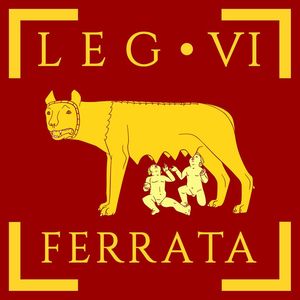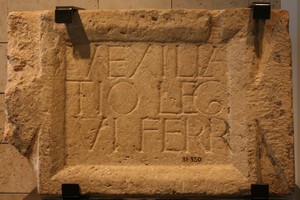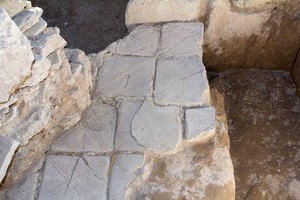Roman Legion - Legio VI Ferrata
The Legio VI Ferrata (Sixth Iron Legion) — a Roman legion formed during the Republic by Gaius Julius Caesar.
Date of existence: The legion was created by Gaius Julius Caesar in 52 BC and lasted until the 4th century AD.
Symbols: Bull and the Capitoline Wolf with Romulus and Remus.
Nickname: The cognomen "Ferrata" translates to iron or armored. This nickname was likely given to the legion for its courage and steadfastness in battles it participated in. Later, it earned the title Fidelis Constans ("forever faithful").
Battle Path
There are two versions of the origin of this legion:
1) The Legion was created by Gaius Julius Caesar in 52 BC.
2) The Legion was created by Gnaeus Pompeius the Great in 52 BC.
Most authors adhere to the date of the legion's creation by Caesar during his famous Gallic War (52-50 BC).
- Legio VI Ferrata began its combat path at a key moment of the Gallic War, namely the siege of Alesia (modern Alise-Sainte-Reine, France) in September 52 BC. After the Gallic War, the legion took an active part in the ensuing Civil War (49-45 BC) between Caesar's and Pompey's supporters.
- Battles of the Civil War involving Legio VI Ferrata: Battle of Ilerda (modern Lleida, Catalonia, Spain) in June-August 49 BC - the first major battle of this war; Battle of Dyrrhachium (modern Durrës, Albania) in the summer of 48 BC; In the decisive Battle of Pharsalus (modern Farsala, Greece) on August 9, 48 BC.
- After this, the legion accompanied Caesar on his Egyptian expedition (48-47 BC), participating in the defense of Alexandria (Egypt) against the forces of Pharaoh Ptolemy XIII (the younger brother of Queen Cleopatra, whom Caesar supported after Ptolemy's servants killed Pompey when he landed in Egypt). Subsequently, the legion, along with Caesar, campaigned in Syria and Pontus (the northeastern region of Asia Minor, bordering the Black Sea).
- egio VI Ferrata participated in the Battle of Zela (modern Zile, northern Turkey) in August 47 BC. In this battle, the Roman forces defeated Pharnaces II, the son of the renowned king of Pontus and adversary of the Romans, Mithridates VI Eupator, Pharnaces II. Ironically, it was Pharnaces II who betrayed his famous father in 63 BC to become king of Pontus. At the same time, he did not agree with the decision of the Romans to transfer the Pontic Kingdom to him without Phanagoria and dreamed of recreating the great Pontic state.
- After these successes, Caesar returned the legion to Italy to receive its well-deserved rewards. However, before that, the legion participated in the final battle of the Civil War - the Battle of Munda (near modern Osuna, Spain) on March 17, 45 BC. After this, the legion received its well-deserved rewards and was disbanded, with its veterans settled in the city of Arles (modern Arles, France).
- Once again, the legion was recreated by Marcus Lepidus, a member of the second triumvirate which arose after Caesar's assassination in 44 BC. The legion sided with the Second Triumvirate and participated in the decisive battle of the civil war (44-42 BC) at Philippi (now the ruins of an ancient Greek city on the Aegean coast, Greece) in October 42 BC.
- After this, according to the terms of the power-sharing agreement among the members of the Second Triumvirate (excluding Lepidus), the legion departed with Mark Antony to the East. Here it helped King Herod the Great gain power over Judea in 37 BC, and in 36 BC participated in Antony's unsuccessful Parthian campaign (40-33 BC).
- In the subsequent civil war between Octavian Augustus and Mark Antony, Legio VI Ferrata sided with Antony and participated in the Battle of Actium (modern cape in the Ionian Sea, on the western coast of Greece) in 31 BC. After Antony's defeat and death, the victorious Octavian transferred the legion to Syria. It is presumed that the legion's camp was in Raphanea in southern Syria (now the valley of Megiddo, Israel).
- In 58 AD, parts of the legion took part in General Corbulo's campaign in Armenia during the Roman-Parthian War (58-63 AD) over Armenia.
- During the First Jewish War (Revolt) (66-73 AD) in 67 AD, four cohorts of the legion participated in the unsuccessful campaign of the proconsul of Syria, Cestius Gallus, against Jerusalem, during which Roman forces were defeated, and the legate of Legio VI Ferrata was killed.
- In 69 AD (Year of the Four Emperors), Legio VI Ferrata went to Italy to support the claims of the commander of the Roman forces in Judea, Vespasian, to the imperial throne in Rome. These forces were led by the governor of Syria, Gaius Mucianus. On the way to Italy, the legion diverted to the Danube and successfully repelled invaders, recapturing the fortresses in Moesia occupied by the Sarmatians (some scholars believe these were not Sarmatians but Dacians). After this, the legion returned to Syria in 70 AD.
- During Emperor Trajan's reign, the legion participated in his Dacian War (106 AD) and Trajan's Armenian campaign (114 AD), aimed at the final conquest of Armenia, which Trajan successfully achieved.
- Under Emperor Hadrian, in 119 AD, Legio VI Ferrata was briefly transferred to Arabia, from where it was sent to Judea to suppress the Bar-Kochba Revolt (132-136 AD).
- In 136 AD, after the suppression of the Bar-Kochba Revolt, Legio VI Ferrata was transferred to Galilee (now Israel), to the city of Caparcotna, which soon came to be called Legio (from the Latin name for legion).
- During the reign of Emperor Antoninus Pius (138-161 AD), the legion was briefly transferred to Africa and then returned to Judea.
- In 162-165 AD, Emperor Lucius Verus used the legion in Mesopotamia. It is believed that the legion participated in the capture of the Parthian capital, Ctesiphon (now ruins 32 km from Baghdad, Iraq).
- In 193 (Year of the five Emperors) Legio VI Ferrata supported Septimius Severus, who eventually became emperor. For its fight against Pescennius Niger, another claimant to the imperial throne in Rome, Legio VI Ferrata received the title Fidelis Constans ("forever faithful").
- In the early 3rd century, in 215 AD, Legio VI Ferrata was still in Palestine.
- The last mention of Legio VI Ferrata dates to the reign of Emperor Philip the Arab (241-249 AD). It is likely that the legion soon suffered significant losses. There is a theory that the legion participated in Emperor Valerian's unsuccessful campaign against the Sassanids in 260 AD, in which the legion suffered heavily and was not restored, as by the time of the composition of the Notitia Dignitatum (4th-5th centuries AD), the legion was no longer listed among the Roman Empire's forces.
Related topics
List of Roman Legions, Legion, Legionnaire, Legio V Macedonica, Legio X Fretensis, Gaius Julius Caesar, Gnaeus Pompey the Great, Mark Antony, Octavian Augustus, Marcus Ulpius Nerva Trajan, Year of the Four Emperors, Year of the Five Emperors





